Publication
Article
Oncology Live®
Tumor Angiogenesis: VEGF Pioneer Honored as Quest for Answers Persists
Author(s):
The scientific strategy of attacking cancer by thwarting angiogenesis has been on a roller coaster ride for the past 40 years
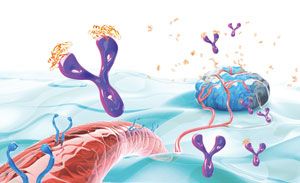
Bevacizumab antibodies released into pathologic angiogenesis.
The scientific strategy of attacking cancer by thwarting angiogenesis has been on a roller coaster ride for the past 40 years, with reactions in oncology research circles ranging from soaring hopes to a current flattening of expectations.
Yet the characterization of vascular endothelial growth factor (VEGF), which is the target of many antiangiogenic therapies, marks an advancement in the understanding of blood vessel development that has paved the way for 5 new oncology drugs, as well as 2 drugs for the treatment of ocular disorders since 2004 (TABLE).
Those were the sentiments that prominent researchers expressed recently as they applauded Napoleone Ferrara, MD, a Genentech scientist credited with isolating and cloning VEGF and building the humanized monoclonal antibody that led to the development of bevacizumab (Avastin) and ranibizumab (Lucentis).
Ferrara received the Dr Paul Janssen Award for Biomedical Research, which Johnson & Johnson sponsors in honor of the late scientist who played a major role in drug development at the company and elsewhere for 50 years. Ferrara was chosen for the award, which carries a $100,000 prize, by an independent panel of scientists, and was recognized during a September 14 symposium at the New York Academy of Sciences.
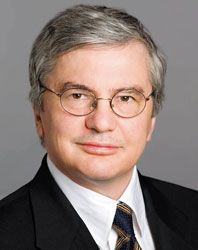
Napoleone Ferrara, MD, of Genentech, is the seventh recipient of the Dr Paul Janssen Award for Biomedical Research.
It is the latest in a series of awards for Ferrara, whose honors include the 2010 Lasker-DeBakey Clinical Medical Research Award.
In the context of cancer research, Ferrara’s work has paved the way for significant advances.
“Dr Ferrara’s discovery of VEGF transformed what we know about blood vessel development,” said Solomon Snyder, MD, a professor of Neuroscience, Pharmacology, and Psychiatry at Johns Hopkins School of Medicine in Baltimore, Maryland, and chair of the Janssen award selection panel, in announcing the honor earlier this year.
“What’s extraordinary here is the diversity of antiangiogenic VEGF pathway—targeting drugs that have been approved,” said Robert S. Kerbel, PhD, a professor at the University of Toronto in Canada, during the symposium. “That’s an amazing achievement in medical oncology.”
The recognition comes at a time when the complexities surrounding antiangiogenic approaches to fighting cancer continue to unfold as researchers seek to answer challenging questions about how such drugs affect patients and why they often do not demonstrate significant gains in overall survival, particularly in breast cancer where the utility of bevacizumab has been hotly debated.
FDA-Apppoved VEGF Therapeutics
Oncology
Drug
Description
Indications
FDA Approval
Bevacizumab
(Avastin)
Genentech
Humanized monoclonal antibody
Metastatic colorectal cancer
Non—small cell lung cancer
Metastatic breast cancera
Glioblastoma
Metastatic renal cell carcinoma (RCC)
2004-2009
Pazopanib
(Votrient)
GlaxoSmithKline
Tyrosine kinase inhibitor (TKI)
Advanced RCC
2009
Sorafenib
(Nexavar)
Bayer/Onyx
TKI
Advanced RCC
Unresectable hepatocellular
carcinoma
2005-2007
Sunitinib
(Sutent)
Pfizer
TKI
Advanced RCC
Gastrointestinal stromal tumors
Pancreatic neuroendocrine tumors
2006-2011
Vandetanib
(Caprelsa)
AstraZeneca
TKI
Medullary thyroid cancer
2011
Eye Disease
Ranibizumab
(Lucentis)
Genentech
Recombinant humanized
IgG1 kappa isotope
monoclonal antibody fragment
Neovascular age-related
macular degeneration
Macular edema following
retinal vein occlusion
2006-2010
Pegaptanib
(Macugen)
Eyetech
Pegylated modified oligonucleotide (aptamer)
Neovascular age-related macular degeneration
2004
a Indication remains on label pending final decision by FDA commissioner on recommendation to revoke.
VEGF indicates vascular endothelial growth factor; IgG1, immunoglobulin G1.
Ferrara himself noted that he is still learning about VEGF after nearly 2 decades of research. “There are so many questions that have been left unanswered,” he said.
At the same time, he disputed the notion that VEGF inhibitors have not met expectations. He noted that VEGF inhibitors have been criticized because they have not succeeded in treating the majority of tumors without encountering resistance while causing few side effects.
“There is only a slight problem with these expectations,” said Ferrara. “Drugs with these characteristics do not exist except in our fantasy, in our imagination. And they’re probably very unlikely to ever exist, based on what we understand about tumor diversity, genomics, and personalized medicine.”
The reality, he said, is that drugs that increase survival for patients with cancer by a few months are successful.
“I never said in any of my papers ... that we’re going to cure cancer, that we’re going to do all these fantastic things,” he added.
Instead, Ferrara maintained that VEGF inhibitors have “a very substantial effect” on tumors if used at early stages and less of an effect if used later in the disease progression. If preclinical data were not “blurred” by expectations, the differences in such data and performance would not be so great, he suggested.
Painstaking Path to Discovery
Ferrara was a young researcher in 1988 when Genentech hired him to investigate a human reproductive hormone. A native of Italy, Ferrara had just finished postdoctoral research at the University of California, San Francisco (UCSF) and was attracted to Genentech’s entrepreneurial atmosphere.
After nearly 2 decades, Ferrara is still learning about VEGF. “There are so many questions that have been left unanswered,” he said.
The company allowed its researchers to spend 25% of their time on questions they found intriguing, and Ferrara immersed himself in exploring the cyclical growth of blood vessels in bovine pituitary cultures in search of the protein that promotes proliferation.
In 1989, he identified the human gene VEGF as one that played an important role in vasculature, and then began to define its activity in the formation of new blood vessels in a range of body functions, including embryonic development, reproduction, and tumor growth.
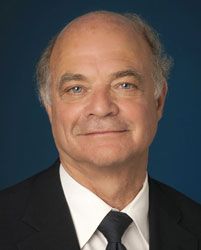
Robert S. Kerbel, PhD University of Toronto in Canada
It was a painstaking process, Ferrara noted. Today, “we have all the secrets of all genes on a chip,” he said, but he began sequencing the gene and developing a humanized anti-VEGF antibody before the era of supercomputers. Not only was such an undertaking arduous from a research standpoint, it also was a “tremendous gamble” for a pharmaceutical company to undertake.
Ferrara’s persistence paid off with the development of bevacizumab, an anti-VEGF monoclonal antibody that is 93% human and 7% murine.
The key moment in its path to patients came in 2003 when a pivotal phase III trial of Avastin in colorectal cancer marked the first clinical validation of the theory that disrupting a tumor’s blood supply inhibited tumor growth and metastasis. The following year, the FDA approved Avastin for the treatment of metastatic colorectal cancer in combination with chemotherapy.
The colorectal cancer trial results proved to be a high point in the research timeline of angiogenesis as an anticancer strategy, said Kerbel, who used the analogy of the roller coaster to describe enthusiasm for the theory during the past 40 years.
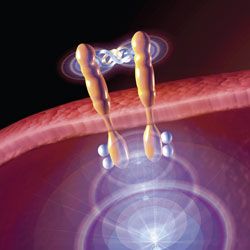
The VEGF ligand binds to VEGFR2 receptors on the surface of endothelial cells, setting off an angiogenic cascade.
Research Perspectives Shift
Like other concepts in cancer research, such as immunology, the understanding of angiogenesis and its role in tumor growth has developed over decades. The term angiogenesis, which means the growth of new blood vessels, dates to the late 1700s, and researchers began defining the vasculature of tumors in the 19th century (Univ Toronto Med J. 2009;87(1):45-49).
A significant advance came in 1939 when A. Gordon Ide published the earliest in vivo images of blood vessel growth in a rabbit in the American Journal of Roentgenology; Ferrara said it was the first study to postulate the idea of a tumor angiogenic factor.
In 1971, surgeon Judah Folkman, MD, initially was rebuffed when he posited his theory in the New England Journal of Medicine that tumor growth is dependent upon angiogenesis. As research continued, excitement for the theory grew and several strategies for inhibiting angiogenesis in tumor growth were explored.
By 1999, 46 antiangiogenic drugs for the treatment of cancer had entered clinical trials, according to the Angiogenesis Foundation. Yet those high hopes were dashed over the next 5 years by a series of disappointing results, Kerbel noted.
Excitement began growing again after the Avastin colorectal cancer trial. However, as antiangiogenic agents have not delivered the dramatic overall survival benefits initially anticipated, current perceptions of such agents in oncology are on a downswing or have reached a plateau, Kerbel said.
For example, Daniel F. Hayes, MD, expressed skepticism about bevacizumab in an editorial in the Journal of the American Medical Association. “Is bevacizumab a boon or a bust? The jury is still out. Although bevacizumab has benefit, it is currently not possible to determine in whom or for how long,” wrote Hayes, clinical director of the Breast Oncology Program at the University of Michigan Comprehensive Cancer Center in Ann Arbor (2011;305(5)506-508).
Kerbel said antiangiogenic cancer therapies— as well as other targeted agents—are hampered by unrealistic, even “ridiculous” expectations generated in part by preclinical studies that may not be based on accurate laboratory models. He also said more clinically relevant endpoints such as progression-free survival should be used instead of overall survival to validate such therapeutics.
“We really have to rethink the way we evaluate drugs at the preclinical level,” Kerbel said.
“
What’s extraordinary here is the diversity of antiangiogenic VEGF pathway-targeting drugs. ”
—Robert S. Kerbel, PhD
Complex Questions Arise
Aside from the question of expectations, as the research into VEGF and its receptors has unfolded, so have the complexities of its nature and its role in the human body. More than a dozen proteins have been identified as angiogenic, with VEGF and basic fibroblast growth factor considered the most important in promoting tumor growth, according to the National Cancer Institute.
Today, VEGF, also known as VEGF-A, is considered one member of a supergene family of growth factors consisting of VEGF-A, VEGF-B, VEGF-C, VEGF-D, platelet-derived growth factor, and placental growth factor. (OncoTargets and Therapy. 2010;3:69-82).
While studies confirm that inhibiting VEGF initially causes the tumor vasculature to regress and thwarts new vessel growth, Hayes and others wonder whether suppressing VEGF signaling might result in a “rebound effect of enhanced neovascularization and tumor growth when suppression is discontinued.”
Find out more >>> A Look at 7 VEGF Inhibitors Currently in Development
Ferrara continues to explore its complexities. VEGF “is spliced into different isoforms that show distinct heparin binding and divisibility,” with the roles of these forms, particularly VEGF receptor 1, still unclear, he said at the symposium.
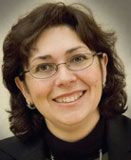
Luisa Iruela-Arispe, PhD University of California Los Angeles
He said unanswered questions include the reasons for resistance to antiangiogenic therapies, where there are “an infinite number of possibilities,” and the ability of tumor cells to resist VEGF inhibitors by recruiting larger numbers of bone marrow cells than can normal cells.
Yet there is no doubt about the powerful nature of VEGF. Ferrara said this is demonstrated by the fact that the loss of a single VEGF-A allele results in “embryonic lethality.”
Luisa Iruela-Arispe, PhD, professor and vice-chair of Molecular Cell and Developmental Biology at the University of California, Los Angeles, has been exploring different vascular growth patterns elicited by soluble versus matrixbound VEGF and the impact preferentially inhibiting one form as opposed to the other might have on tumors.
“VEGF is a Swiss [Army] knife,” Iruela-Arispe said at the symposium. “The more I look into it, the more amazed I am of this remarkable molecule that has different functions and an incredible level of versatility that impacts biology at many, many different levels.”
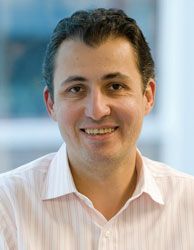
Dan G. Duda, DMD, PhD Harvard Medical School, Massachusetts General Hospital in Cambridge
The research community’s understanding of angiogenesis “was really in its infancy” in 2004, with many assumptions that have since proved either completely or partially inaccurate, she said.
“I think that it is really critical to step back and look at the basic science again, to further understand the biology of these molecules and their impact in different settings, and then to define and complement the therapies that are already in place,” said Iruela-Arispe.
“We’re still trying to understand how these therapies work in patients,” noted syposium speaker Dan G. Duda, DMD, PhD, assistant professor of Radiation Oncology at Harvard Medical School and associate biologist at the Edwin L. Steele Laboratory for Tumor Biology at Massachusetts General Hospital in Boston.
Moving forward involves identifying biomarkers that are needed to determine which patients would most benefit from VEGF-inhibiting therapies, said Duda. He said in an interview that biomarker research in the angiogenic area is in a very early stage and would likely need a concerted effort by pharmaceutical companies and patient advocates to support such research.
“There’s no debate that these agents are active in patients,” said Duda.
Angiogenesis Illustrations Courtesy of Genentech









